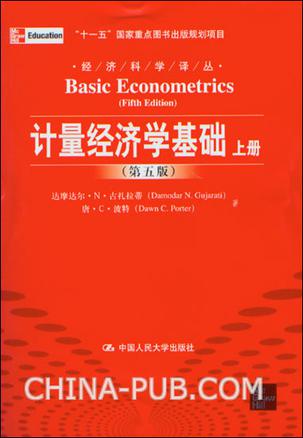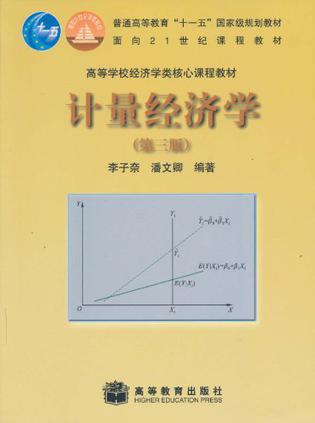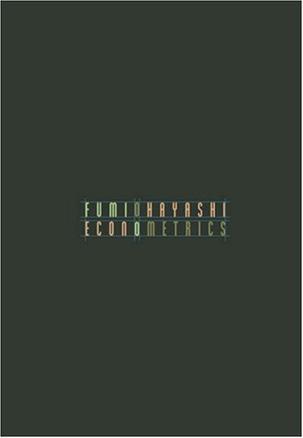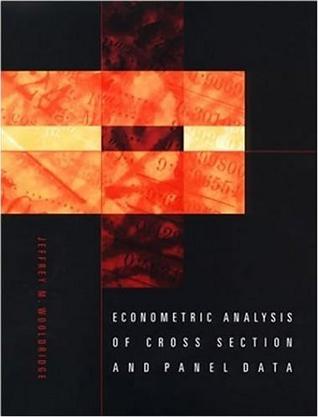-

Introductory Econometrics for Finance
This introduction to contemporary topics in the modelling of financial time series is data and problem driven, giving students the skills to estimate and interpret models, and intuitively grasp the underlying theoretical econometrics. An introductory knowledge of calculus, algebra, statistics and regression analysis is assumed. The book focuses on the needs of finance students and uses pedagogic textbook features throughout, notably in the later chapters, which offer advice on planning and executing a project in empirical finance, and which also evaluates sources of on-line financial information. -

计量经济学基础 第5版 上下册
《计量经济学基础(第5版)(上下册)》是一本经典的初级计量经济学教材,第一版问世至今已有三十年。对于初涉计量经济学而又没有太多数学背景的读者来说,这本书可以帮助你在短时间内了解计量经济学的脉络。本书的主要特点是: (1)读者不需要高深的数学知识,只要具备基本的数学知识就可以阅读本书; (2)运用大量的经济计量模型实例,特别是图形进行分析,易于读者的理解; (3)书中突出强调了计量经济学对经济和金融数据的应用分析,一些模型的引用对相关专业的读者解决实际问题很有指导意义。 -

计量经济学
本书融计量经济学理论、方法与应用为一体:以中级水平内容为主,适当吸收初级和高级水平的内容;以经典线性模型为主,适当介绍一些适用的非经典模型。全书形成了一个独具特色的内容体系。 全书详细论述了经典的单方程计量经济学模型的理论方法,适当介绍了联立方程计量经济学模型和时间序列计量经济学模型的理论方法,并引入了几类扩展的单方程计量经济学模型。在计量经济学应用模型中,本书着重讨论了模型类型选择、模型变量选择、模型函数关系设定和模型变量性质设定的原则和方法。在详细介绍线性回归模型的数学过程的基础上,各章的重点不是理论方法的数学推导与证明,而是对实际应用中出现的实际问题的处理,并尽可能与中国的模型实例相结合。 本书既包含了由教育部经济学学科教学指导委员会制定的高等学校经济学科本科计量经济学课程教学基本要求的全部内容,又为学有余力者提供了进一步学习的指南。该书适合于作为各类高等院校经济、管理学科本科生的教材或教学参考书,也可供具有一定数学、经济学和经济统计学基础的经济管理人员和研究人员阅读和参考。 -

Econometrics
Hayashi's "Econometrics" promises to be the next great synthesis of modern econometrics. It introduces first year PhD students to standard graduate econometrics material from a modern perspective. It covers all the standard material necessary for understanding the principal techniques of econometrics from ordinary least squares through cointegration. The book is also distinctive in developing both time-series and cross-section analysis fully, giving the reader a unified framework for understanding and integrating results. "Econometrics" has many useful features and covers all the important topics in econometrics in a succinct manner. All the estimation techniques that could possibly be taught in a first-year graduate course, except maximum likelihood, are treated as special cases of GMM (generalized methods of moments). Maximum likelihood estimators for a variety of models (such as probit and tobit) are collected in a separate chapter. This arrangement enables students to learn various estimation techniques in an efficient manner. Eight of the ten chapters include a serious empirical application drawn from labor economics, industrial organization, domestic and international finance, and macroeconomics. These empirical exercises at the end of each chapter provide students a hands-on experience applying the techniques covered in the chapter. The exposition is rigorous yet accessible to students who have a working knowledge of very basic linear algebra and probability theory. All the results are stated as propositions, so that students can see the points of the discussion and also the conditions under which those results hold. Most propositions are proved in the text. For those who intend to write a thesis on applied topics, the empirical applications of the book are a good way to learn how to conduct empirical research. For the theoretically inclined, the no-compromise treatment of the basic techniques is a good preparation for more advanced theory courses. -

计量经济分析(上下册)
《计量经济分析》(第五版)一书的主要特色:内容进行了大幅重构。为了便于学生理解书的内容,我们对全书内容进行了重构。以应用为导向。学生将学会如何做计量经济分析。覆盖的专题更加全面。本书包括古典估计、横截面数据分析以及更多的时间序列数据和面板数据分析。包含众多应用实例。为了向学生说明如何进行计算,我们给出了应用案例的详细解答。线性与非线性方法并重。现在的计量经济分析软件,使得非线性估计也轻而易举,所以本书包含了这方面的一些内容。 -

Econometric Analysis of Cross Section and Panel Data
This graduate text provides an intuitive but rigorous treatment of contemporary methods used in microeconometric research. The book makes clear that applied microeconometrics is about the estimation of marginal and treatment effects, and that parametric estimation is simply a means to this end. It also clarifies the distinction between causality and statistical association.
The book focuses specifically on cross section and panel data methods. Population assumptions are stated separately from sampling assumptions, leading to simple statements as well as to important insights. The unified approach to linear and nonlinear models and to cross section and panel data enables straightforward coverage of more advanced methods. The numerous end-of-chapter problems are an important component of the book. Some problems contain important points not fully described in the text, and others cover new ideas that can be analyzed using tools presented in the current and previous chapters. Several problems require the use of the data sets located at the author's website.